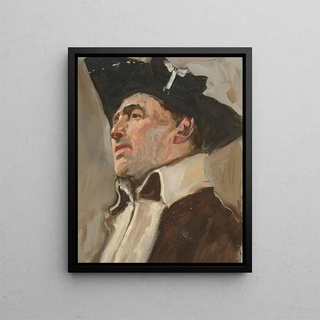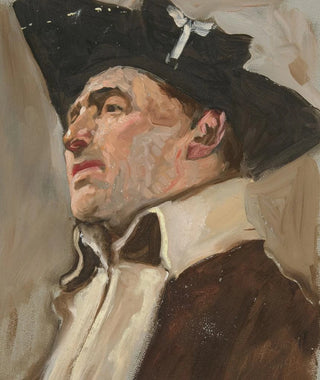Art print Study of a soldier - Edwin Austin Abbey | Art print


View from behind

Frame (optional)
In the vast panorama of art, some works stand out for their ability to capture fleeting moments and transform them into visual stories. "Study of a Soldier - Edwin Austin Abbey" is one of those creations that manages to transport the viewer to the heart of a bygone era, while evoking universal emotions. This piece, imbued with melancholy and reflection, opens a window into the life of a soldier, revealing the complexities of his existence through the lens of art. Contemplating this work, one feels a deep connection with the past, an invitation to explore the nuances of humanity in times of conflict.
Style and uniqueness of the work
Edwin Austin Abbey's work is distinguished by its unique style, where mastery of drawing and fine details combine to bring characters and scenes to life. In "Study of a Soldier," Abbey uses delicate shades and shadow play to emphasize the features of his subject, creating an atmosphere that is both intimate and poignant. The facial expressions and postures of the characters are carefully crafted, demonstrating meticulous observation of the human condition. The artist manages to capture not only the physical appearance of his model but also the complex state of mind that inhabits him. In doing so, he transcends simple portraiture to offer a reflection on sacrifice, duty, and heroism—timeless themes that continue to resonate through the ages.
The artist and his influence
Edwin Austin Abbey, a prominent figure of the late 19th century, made his mark with a style that combines realism and romanticism. His artistic training, influenced by the Pre-Raphaelites and European traditions, allowed him to develop a particular sensitivity to details and atmospheres. Abbey was also a pioneer in the use of color and light, which is reflected in "Study of a Soldier." His artistic legacy extends beyond his works, inspiring many contemporary artists to explore themes of war and memory. By integrating narrative elements into his compositions, Abbey

Matte finish

View from behind

Frame (optional)
In the vast panorama of art, some works stand out for their ability to capture fleeting moments and transform them into visual stories. "Study of a Soldier - Edwin Austin Abbey" is one of those creations that manages to transport the viewer to the heart of a bygone era, while evoking universal emotions. This piece, imbued with melancholy and reflection, opens a window into the life of a soldier, revealing the complexities of his existence through the lens of art. Contemplating this work, one feels a deep connection with the past, an invitation to explore the nuances of humanity in times of conflict.
Style and uniqueness of the work
Edwin Austin Abbey's work is distinguished by its unique style, where mastery of drawing and fine details combine to bring characters and scenes to life. In "Study of a Soldier," Abbey uses delicate shades and shadow play to emphasize the features of his subject, creating an atmosphere that is both intimate and poignant. The facial expressions and postures of the characters are carefully crafted, demonstrating meticulous observation of the human condition. The artist manages to capture not only the physical appearance of his model but also the complex state of mind that inhabits him. In doing so, he transcends simple portraiture to offer a reflection on sacrifice, duty, and heroism—timeless themes that continue to resonate through the ages.
The artist and his influence
Edwin Austin Abbey, a prominent figure of the late 19th century, made his mark with a style that combines realism and romanticism. His artistic training, influenced by the Pre-Raphaelites and European traditions, allowed him to develop a particular sensitivity to details and atmospheres. Abbey was also a pioneer in the use of color and light, which is reflected in "Study of a Soldier." His artistic legacy extends beyond his works, inspiring many contemporary artists to explore themes of war and memory. By integrating narrative elements into his compositions, Abbey
12,34 €






